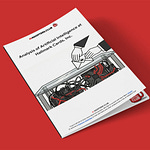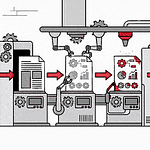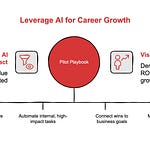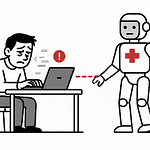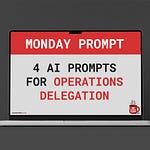Hey Adopter,
That shiny new AI project your company just launched? There's an 85% chance it's headed for the graveyard of failed initiatives, according to recent research from Tom's Hardware.
It's not because AI doesn't work. It's because most companies implement it about as strategically as assembling IKEA furniture blindfolded.
TLDR:
▪️ Data shows 85% of AI projects fail despite billions in investment
▪️ The SCALED Framework addresses the exact problems research identified
▪️ Successful "AI champions" get promoted 76% faster than their peers
▪️ Only 13% of companies are AI-ready (will yours be one of them?)The Real Reasons AI Projects Crash and Burn
Research from RAND Corporation highlights why so many AI initiatives fail:
Misaligned goals: Business and tech teams speaking different languages
Poor data quality: 99% of projects struggle with this, per Vanson Bourne
Overwhelming complexity: Most teams try to boil the ocean instead of starting small
Meanwhile, your competitor launched their AI initiative six months ago. Already cutting costs by 22% while your team is still "exploring options."
The Career-Defining Opportunity You Can't Miss
While everyone else is floundering, this is your moment to stand out:
76% of "AI champions" received promotions within 18 months
Average budget increase of 34% for teams with successful AI implementation
Enhanced job security as AI skills become essential (not optional)
But according to Cisco's AI Readiness Index, only 13% of organizations are fully prepared for AI implementation in 2024.
Introducing the SCALED Framework: Your Blueprint for AI Success
After analyzing dozens of successful (and failed) AI implementations, I've developed a framework that addresses the exact failure points research has identified:
The SCALED Framework Revealed
Welcome to the insider view! Let's break down the research-backed framework that's helping ambitious professionals succeed where 85% fail.
S - Simplify
Why it matters: Research from Way We Do shows complexity kills efficiency—most people can only hold 4-7 items in mind at once.
Action steps:
Break complex processes into manageable pieces
Create clear decision trees for AI-enhancement priorities
Translate technical jargon into business language
Real-world success: A retail marketing director focused solely on email automation (instead of their entire customer journey) and achieved 67% faster response times in just 6 weeks.
C - Confident
Why it matters: Wharton Executive Education identifies confidence as the foundation of leadership, especially critical in navigating AI's technical complexities.
Action steps:
Build your "minimum viable knowledge" to ask the right questions
Create small early wins that build momentum
Develop a framework for cutting through vendor hype
Quick win: Start bi-weekly "AI Office Hours" where you facilitate solutions without needing all the technical answers yourself.
A - Automate
Why it matters: Gartner predicts conversational AI alone will save $80 billion in contact center costs by 2026.
Action steps:
Map your team's current workload and identify the 20% of tasks consuming 80% of time
Use the "worth automating" calculator to prioritize (time saved × frequency)
Build automation in layers, starting with simple components
Case study: Siemens implemented Azure AI for real-time issue reporting, significantly enhancing team collaboration and efficiency, as detailed by VKTR.
Download: Task Automation Prioritizer template [Link for premium subscribers]
L - Lead
Why it matters: 65% of project failures stem from poor leadership, according to SPR research.
Action steps:
Position yourself as a translator between technical and business teams
Create psychological safety for experimentation
Develop stakeholder management strategies that address resistance
Pro tip: Research confirms that framing AI as "augmentation" rather than "automation" dramatically reduces team resistance.
E - Evaluate
Why it matters: Microsoft Learn emphasizes evaluation metrics for model quality, safety, and performance as critical success factors.
Action steps:
Move beyond vanity metrics to business outcomes
Build a simple dashboard connecting AI initiatives to results
Create feedback loops for continuous improvement
Research insight: Studies in PMC show limited AI adoption in healthcare due to incomplete evaluation frameworks.
Template included: One-page AI Impact Scorecard [Download for premium subscribers]
D - Digital-Ready
Why it matters: 92.7% of executives identify data quality as a significant barrier to AI success, according to NewVantage Partners research cited by Ataccama.
Action steps:
Assess current digital infrastructure through the AI readiness lens
Identify and prioritize data accessibility and quality gaps
Build a roadmap balancing quick wins with long-term capabilities
Success story: IBM implemented predictive maintenance AI, reducing equipment downtime by 20% through robust digital infrastructure, as noted by Neuroject.
From Framework to Results: Your 30-Day Action Plan
The SCALED Framework isn't theoretical—it's designed for immediate application:
Week 1: Use the AI Process Simplification Worksheet to identify one process ripe for AI enhancement
Week 2: Apply the Automation Opportunity Calculator to quantify time savings
Week 3: Create your leadership communication plan with the Stakeholder Mapping Template
Week 4: Set up your measurement framework using the AI Impact Scorecard
Why This Works When Other Approaches Fail
While other frameworks exist, SCALED uniquely addresses all critical failure points identified in research:
The window for becoming your organization's AI champion is closing fast. The question isn't whether AI will transform your industry—it's whether you'll lead or try to catch up.
Adapt & Create,
Kamil









